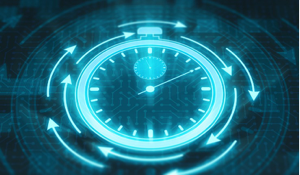When people consider adding payment processing to their business operations, their first thought is credit and debit cards quickly followed by ACH and check processing. The truth is, there are a lot of options out there, and they all come with their own unique benefits.
While digital payment methods, such as digital wallets and near field communication (NFC) payments, are growing in popularity, the three primary non-cash payment methods are credit/debit cards, ACH, and physical checks. It’s sensible for businesses to offer multiple payment methods – it’s a convenience for customers and ultimately means more payments and fewer delinquencies for the business.But of the three most common methods, which one is the fastest?
ACH is Getting Faster
If you are a B2B business, your payments program has to
include ACH processing. In a 2018 Statista survey, 53% of survey respondents identified ACH as the most preferred B2B payment method in North America.
The good news is ACH processing is faster than checks, especially with the arrival of same day funding. Same day ACH lets businesses collect funds faster and reduces the risk of returned ACH transactions due to insufficient funds. If payments are made before the cutoff time, the funds are available in about 3-4 hours, no later than 5pm EST that same day. If the transaction is processed after the cut-off time, funds are available the next banking day by 9am RDFI (receiving depository financial institution) local time. Of course, there are exceptions. High-value transactions above $25,000 are not yet eligible for same day funding, but NACHA recently passed a rule that will
increase the per-transaction dollar limit for same day ACH transactions from
$25,000 to $100,000 effective March 20, 2020. Another important thing to note
is ACH transactions can’t be processed on banking holidays when the Federal
Reserve Bank is closed.
Checks
Although checks are still around and popular, they were by far the least preferred payment method in the survey. There’s really no surprise here, thanks to several reasons, including:
- Travel Time: if physical checks are mailed, 3-5 days are wasted before the payment even begins to be processed.
- Resource Drain: a person must handle the checks, which takes away from other duties and responsibilities. In order to maintain good financial controls and prevent embezzlement, a second person usually deposits or posts the checks.
- Process Time: whether you receive or send them, it takes time and money to cut, mail and process the checks. Small businesses can lose between $4-20 processing a check.
So how long does it take a check to clear? It’s a good question and no one seems to know for sure. The biggest variable is the bank because every bank’s policy is different. When it comes to checks, two banks are involved – the merchant’s bank and the consumer’s bank. Best case scenario, funds become available 24-48 hours after the check is deposited, but it can sometimes take much longer. Even with remote check deposit, banks still place a hold on the funds.
According to PYMNTS.com, checks are still around because they meet three main criteria for businesses:
- Checks move money from one entity to another.
- They allow data and documents to travel along with the payment (for proper tracking, diligence, accounting, and taxes).
- Businesses can develop workflows around them.
While checks are a prominent form of payment, their dominance is shrinking due to their resource requirements and time constraints.
Card Payments
Merchants who accept card payments are generally funded for those transactions within 24 to 48 hours – much faster than the funding time for most paper check scenarios. The settlement time for card payments is now even faster thanks to push payment technology. With this new technology, funds are available within 30 minutes; in most cases, however, they are available within seconds after transaction approval. The real-time processing and funding of push payments eliminates the waiting period associated with ACH and paper checks.
The Fastest Combo
So which payment method is fastest? It’s a combination of ACH with its same day funding enhancements and push-to-card payments. Both enable funds to clear the same day, giving you quick, if not immediate, access to money.
